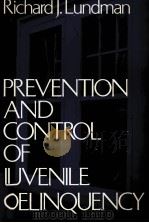《Unraveling Juvenile Delinquency》
| 作者 | 编者 |
|---|---|
| 出版 | The Commonwealth Fund |
| 参考页数 | 399 |
| 出版时间 | 1950(求助前请核对) 目录预览 |
| ISBN号 | 无 — 求助条款 |
| PDF编号 | 812540258(仅供预览,未存储实际文件) |
| 求助格式 | 扫描PDF(若分多册发行,每次仅能受理1册) |

PART ONE.THE PROBLEM1
Ⅰ.General Orientation3
Inadequacy of Knowledge of Crime Causation3
Inadequacy of Theories of Crime Causation4
Need for Eclectic Approach to Study of Crime Causation7
PART TWO.THE TECHNIQUE11
Ⅱ.Design of the Research13
Definition of Delinquency13
Control of the Inquiry14
Levels of the Inquiry15
Ⅲ.Establishing the Project19
Finding a Suitable Locale19
Permission to Examine Delinquents20
Permission to Examine Non-Delinquents21
Overcoming Difficulties22
Staff of the Research24
Ⅳ.Selecting and Matching Delinquents and Non-Delinquents27
Selecting Delinquents27
Selecting Non-Delinquents28
Obtaining Parental Permission to Examine Non-Delinquents29
Selecting Neighborhoods30
Selecting Public Schools32
Verifying Age32
Determining Ethnic Origin32
Determining Intelligence Quotient33
Matching Delinquents and Non-Delinquents by Pairs33
Evidences of Success of Matching35
Ⅴ.Exploring Family and Personal Background41
Delimiting the Social Inquiry41
Assuring Uniformity in Social Histories42
Identification Data and Vital Statistics43
Consulting Social Service Indices44
Clearing through Massachusetts Board of Probation45
Interviewing in Homes45
Securing Data from Social Agency Records49
Securing Data from Peno-correctional Agencies50
Clearing through Massachusetts Department of Mental Health50
Gathering School Histories50
Closing the Cases52
Ⅵ.Testing and Examining Delinquents and Non-Delinquents54
Physique Study54
Medical Examination55
Intelligence and Achievement Tests56
Rorschach Test57
Psychiatric Interview60
Arrangements for Examining Delinquents62
Arrangements for Examining Non-Delinquents63
Maintaining the Cooperation of the Boys64
Completing Tests and Examinations64
Ⅶ.Preparing Data for Statistical Treatment67
Testing Definitions,Subcategories,and Schedules67
Safeguards in Gathering and Recording Data69
Checking the Findings70
Editing the Schedules72
Preparing Data for Tabulation73
PART THREE.THE FINDINGS77
Ⅷ.Home Conditions of Delinquents and Non-Delinquents When Selected for the Research79
Neighborhood79
Physical Aspects of Home80
Economic Circumstances of Family84
Household88
Summary91
Ⅸ.Setting of Family Life93
Milieu of Parents93
Adequacy of Parents for Responsibilities99
Parents' Dependence on Social Welfare102
Economic Circumstances of Parents104
Employment History of Father106
Summary107
Ⅹ.Quality of Family Life108
Orderliness of Household108
Cultural Refinement of Home108
Family Pride109
Conduct Standards of Home110
Conjugal Relations of Parents111
Dominant Parent112
Supervision by Mother112
Recreational Outlets of Family113
Cohesiveness of Family115
Summary115
Ⅺ.The Boy in the Family117
Vital Statistics117
Household Instability120
Affectional Relationship between Boy and Parents125
Affection of Brothers and Sisters for Boy127
Concern of Parents for Welfare of Boy128
Discipline of Boy by Parents130
Summary133
Ⅻ.The Boy in School135
School Status135
Retardation138
Subject Preferences138
Scholarship and Achievement140
Variability in Achievement143
Attitude toward School143
Relation to Schoolmates145
Earliest Maladaptive Behavior in School146
Truancy148
Behavior during Last School Year149
Characteristics of Attack and Withdrawal151
Summary153
ⅩⅢ.The Boy in the Community155
Neighborhood Ties155
After-School Employment158
Household Duties159
Use of Leisure Time160
Adventurous Activities162
Companions163
Supervised Recreations164
Church Attendance167
Summary167
ⅩⅣ.Physical Condition169
Developmental Health History170
Height and Weight172
Dynamometric Strength172
Bony Skeleton and Palate172
Teeth173
Nose and Throat173
Eyes and Ears175
Heart and Lungs176
Abdomen and Genitalia176
Skin177
Glands177
Nervous System178
Acquired Motor Handicaps180
General Health180
Summary181
ⅩⅤ.Bodily Constitution183
Gross Bodily Measurements184
Anthropometric Indices187
Bodily Disproportions191
Masculine Component192
Somatotypes192
Summary196
ⅩⅥ.Verbal and Performance Intelligence198
Verbal Intelligence199
Performance Intelligence202
Comparison of Verbal and Performance Intelligence204
Variability in Components of Verbal and Performance Intelligence205
Summary206
ⅩⅦ.Qualitative and Dynamic Aspects of Intelligence209
Originality210
Creativity210
Banality210
Power of Observation210
Unrealistic Thinking212
Common Sense212
Intuition212
Phantasy213
Over-Verbalizing Intelligence213
Methodical Approach to Problems213
Potential Capacity for Objective Interests214
Summary214
ⅩⅧ.Character and Personality Structure215
Nature of Rorschach Test215
Attitudes toward Authority and Society218
Feelings of Insecurity,Anxiety,Inferiority, and Frustration221
Kindliness and Hostility226
Dependence and Independence231
Goals of Strivings234
Some General Qualities of Personality236
Mental Pathology239
Summary240
ⅩⅨ.Dynamics of Temperament244
Deep-Rooted Emotional Dynamics245
Appetitive-Aesthetic Tendencies246
Personality Orientation246
Emotional Conflicts and Their Sources247
Method of Resolving Conflicts250
Summary251
PART FOUR.THE SIGNIFICANCE255
ⅩⅩ.Prediction of Delinquency257
Selection of Feasible Predictive Devices258
Method of Constructing a Prediction Table259
Prediction Table Constructed from Factors of Social Background260
Prediction Table Constructed from Character Traits Determined in Rorschach Test262
Prediction Table Constructed from Personality Traits Determined in Psychiatric Interview264
Comparison of Prediction Tables from Social, Rorschach,and Psychiatric Data265
Further Exploration267
ⅩⅪ.Dynamic Pattern of Delinquency272
Non-Causal Factors272
Factors with Probable Causal Significance273
Behavior Reflecting Significant Traits276
The Causal Complex281
ⅩⅫ.Looking Forward284
APPENDICES A - E291
Appendix A.Criminal Record of Delinquents293
Appendix B.List of Matched Pairs of Delinquents and Non-Delinquents297
Appendix C.A Comparative Study of the Morphological Characteristics of Delinquents and Non-Delinquents&by Carl C.Seltzer,Ph.D307
Appendix D.Some Detailed Findings of the Wechsler-Bellevue and Stanford Achievement Tests351
Appendix E.Some Notes on the Use of the Rorschach Test&by Ernest G.Schachtel363
1950《Unraveling Juvenile Delinquency》由于是年代较久的资料都绝版了,几乎不可能购买到实物。如果大家为了学习确实需要,可向博主求助其电子版PDF文件(由 1950 The Commonwealth Fund 出版的版本) 。对合法合规的求助,我会当即受理并将下载地址发送给你。
高度相关资料
-

- JUVENILE DELINQUENCY TRENDS AND PERSPECTIVES
- 1984 THE GUILFORD PRESS
-

- Juvenile delinquency
- 1932
-

- JUVENILE DELINQUENCY IN A FREE SOCIETY
- 1969 DICKENSON PUBLISHING COMPANY
-

- JUVENILE DELINQUENCY SECOND EDITION
- 1990 MACMILLAN PUBLISHING COMPANY NEW YORK
-

- DELINQUENCY THE JUVENILE OFFENDER IN AMERICA TODAY
- 1956 RANDOM HOUSE NEW YORK
-

- CONCERNING JUVENILE DELINQUENCY PROGRESIVE CAHNGES IN OUR PERSPECTIVES
- 1942 COLUMBIA UNIVERSITY PRESS
-

- JUVENILE DELINQUENCY THIRD EDITION
- 1982 HOUGHTON MIFFLIN COMPANY
提示:百度云已更名为百度网盘(百度盘),天翼云盘、微盘下载地址……暂未提供。➥ PDF文字可复制化或转WORD







